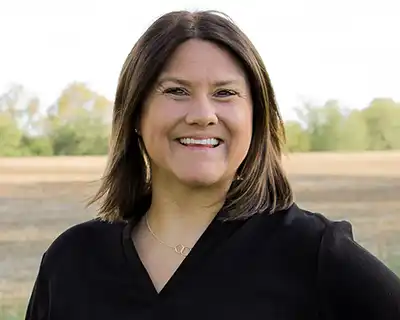Throughout 2021, Trust In Food is inviting leaders of the Founding Partners of America’s Conservation Ag Movement to share their vision for the future of conservation and sustainability in U.S. agriculture. In this post, we spotlight Jon Doggett, CEO at National Corn Growers Association.
Tell us a bit about yourself. How did you arrive in this leadership role within your organization, and how does a commitment to sustainability/conservation inform how you show up to work each day?
I’m a Montana ranch kid. I grew up on a cattle and sheep ranch in central Montana and graduated from the University of Montana. (Go Grizzlies!) I was in the farm equipment industry for part of the ‘80s, which was not particularly great. I had a very large Allis-Chalmers district, and we had the drought the same year we had the Payment-In-Kind (PIK) program. We went from selling 135 combines in the district to selling eight. That wasn’t going to work.
A friend of mine was working for one of the Montana congressmen. We had two members of congress back then. I went to work for Congressmen Ron Marlenee, who represented the eastern two-thirds of the state, on Capitol Hill.
Later, I worked for the National Cattlemen’s Association (now the National Cattlemen’s Beef Association, or NCBA) on the public lands side. I worked for the American Farm Bureau Federation for 11 years and ran the D.C. office for the National Corn Growers Association for 16 years. Three years ago, they named me CEO.
I remember being in the back at the staff table in 1300 Longworth, which is the hearing room for the very powerful U.S. House Agriculture Committee back in 1989. There was this thing called Low-Input Sustainable Agriculture (LISA). My boss was a farmer from northeastern Montana, and he kept saying, ‘It needs to be High-Input Sustainable Agriculture.’ I just remember hearing from that point on about sustainability.
I wish I had a dime for every time I heard a farmer or someone in ag say, ‘We don’t want Walmart or Amazon to tell us what sustainability is. That’s our job.’ We sat on it a long time. We didn’t do it. Over the last 10 years, we’ve kind of started warming up. It isn’t that we weren’t doing the right stuff. It’s that we weren’t talking about it. If you don’t talk about it, it doesn’t exist in the world.
One of the reasons I like talking about sustainability is that it gives us an opportunity to talk about the great things our growers are doing. That’s kind of cool because it’s been embraced across society, across our economy by a wide variety of people. It’s so easy to engage in the sustainability discussion. It gives us a platform.
What’s one book you’ve read recently that’s challenging how you think about conservation or the future of food and agriculture?
I’m a history buff, and I’ve been reading a lot of stuff about the Second World War, specifically the Pacific Theater. It was interesting to read that so much of what the Japanese did was to look for resources. That’s why they took over New Guinea, the Malaysian Peninsula and Vietnam, which was then French Indochina. They were looking at ways to acquire the things they didn’t have in their home islands: more importantly oil, but also a lot of food.
There are several ways you can go ahead and acquire those kinds of resource for your population. One is you can go to war, which isn’t a hell of a good idea. Or we have world trade where we have transparency, and we have an ability to engage in economic activity that is transparent and that gives us opportunity to talk about sustainability.
We are having these opportunities that we didn’t have before. We know we’re the greatest stewards of the land here in the U.S., but there’s a lot of good farmers around the world. I’ve been to Asia and you see those folks on little two-acre parcels. You think, ‘What’s their mindset?’. It probably isn’t a lot different than most of the folks I work for. Reading a lot of history shows how much conflict has been created around accessing resources. Talking about sustainability in the broadest sense helps define how we will interact with one another and have access to those economic resources.
In a sentence, describe NCGA for executives in our audience who are unfamiliar with your work.
We represent the interests of the 300,000 or so folks that produce corn every year in this country. We have 40,000 dues-paying members. We are primarily financed by state checkoff dollars. NCGA and its 50 affiliated state organizations work together to create and increase opportunities for corn growers. Thanks to our partnership with our state organizations, we are able to work on a number of projects including new uses, next generation dried distillers grains with solubles (DDGS), getting higher ethanol blends and much more. And, we can do all of it with corn, an abundant and sustainable crop.
What is the biggest conservation challenge your organization is facing, and how are you navigating possible ways to address and overcome that challenge?
I see the challenge to more conservation being in the economic sustainability that we have to have. When we had those commodity price upswings 10 to 11 years ago, we started seeing this really cool thing: People were making money, and kids came back to the farm.
That does two things: First, the kid comes back and challenges dad or grandpa, ‘Let’s try something new, let’s try a new conservation practice, I heard about this in school.’ They look at things with fresh eyes and have that conversation in the shop or around the supper table. Second, they have to have enough profit in the organization to bring the kid back to the farm and to do new things in conservation. There’s a little risk there. With a little profit, ‘We’ll try this for a couple of years. It isn’t going to break us.’ You’ve got to have some profit to incentivize people.
One of the things I’ve been pushing for is to get more of our younger growers involved. It’s also OK for dad to go to Corn Growers meetings so the kid can run the farm for a couple days. My dad was a county commissioner and on the bank board, and my brother absolutely loved it. Dad was gone a couple days every other week, so he could run the farm. We continue to need new blood.
What surprised you about the publication of NCGA’s first-ever Corn Sustainability Report this June? What were some of the most important details about that report?
I don’t know if I was surprised, but I got a lot of calls. And I got texts and emails. People said, ‘This is great.’ I think those responses really gave it a lot of validation across our members and a lot of validation with folks in other organizations and with our value-chain stakeholders.
Most importantly, this report was put together by farmers. In 2019, NCGA formed a Corn Sustainability Advisory Group. This group—comprised largely of U.S. corn farmers—were instrumental in all decision-making, including setting the sustainability goals. It was a farmer-led process. That’s really important as well.
How are corn farmers feeling and thinking about climate, carbon and regenerative ag, and where do they see themselves fitting in? What can the industry do to meet corn farmers where they are on these issues where historical barriers to conversation might have existed because of the terms we use to talk about sustainability?
It’s now a subject that is openly discussed in our meetings but, importantly, discussed in a few coffee shops around the country. We were cool kids before we knew we were cool kids. We are a little bit different than, say, potatoes or tart cherries that are more direct to the consumer. Not many people eat field corn.
Some of our downstream partners at companies—a sustainability officer or vice president or whatever their title might be—talk about what it is that they need. The issue with that is, do they want practices, or do they want outcomes?
Outcomes are a much better way to go. If you do practices, you can do cover crops in Missouri, but it’s really hard to do cover crops in North Dakota. The one-size-fits-all approach or the mandates that make no agronomic sense really turn our folks off. Give us where you want us to go, and we’ll get there.
We don’t have anything to hide. Our folks work toward sustainability and know that the product or commodity they’re producing is of high quality, and that it’s sustainably grown. Corn plants are a wonderful thing: They take air and put it in the ground.
U.S. corn plays an important role as a biofuel. How do you see the national conversation about the electric economy – including President Biden’s recent executive order seeking half of all new-car sales being zero-emissions vehicles by 2030 – impacting corn’s biofuel future and the sustainability implications of that future?
We have 160,000 gas stations in this country. We have 260 to 270 million light-duty vehicles in this country, almost all of which are internal-combustion driven. We’re not going to turn that around next year, or in 10 years, or in 20 years, or in 30 years.
There are two things we would like. We want an opportunity to have more ethanol in the tank because the addition of ethanol has good environmental impacts. Corn ethanol is a lot better for the environment than petroleum. If we can start going from 10% to 20% to 30% or more over the next few decades, that’ll be helpful. But there’s still a lot of places we could put more ethanol in the tank. If we had more E15 in the tank, we would be impacting the environment in a very positive way immediately.
We have the product now that is at the forefront of being able to do the things society says they want us to do. We have farmers involved in ethanol plants, and they’ve validated this. They can raise the corn crop, sequester enough carbon to raise that crop to offset the production of the corn, transport corn to the ethanol plant, take the corn and make it into ethanol. It’s a zero-sum game. Petroleum guys can’t say that. That’s not true in every ethanol plant, but we’re getting there. We’re the solution for today.
No. 2 is we want a level playing field. If you want to compare a car burning 15% ethanol and a car being powered by a coal-fired plant, those are two very different things. Where are they getting the electricity from? We think that ought to be looked at. Where are the metals coming from for those batteries and the other components of that vehicle? There’s a lot of things we need to look at. We’re proud of where our industry is.
I’ve seen fads come and go. Back in 2008-09, car companies said we were going to all flex-fuel vehicles, that we would run 85% ethanol in them, ‘Go green, pump yellow.’ There’s a lot of hype there. It didn’t happen. I think we’re going to have electric vehicles as a big component, but it isn’t going to happen overnight. We welcome the transparency that needs to be provided to compare internal-combustion engines with ethanol versus electric cars. In some places, electric cars are fine.
When you ask someone, ‘Why did you buy a Tesla?,’ I have yet to have anybody say, ‘I’m doing it for the environment.’ I’ve talked to a dozen Tesla owners. One I met outside a Five Guys told me, ‘It goes like a bat out of hell.’ He didn’t care about anything else but that.
What three conservation trends have you most excited and optimistic about the future of U.S. agriculture and farming in the next four years, relative to NCGA’s sustainability priorities?
I am very pleased to hear Secretary Vilsack and other folks in our government, political and nonpolitical being very, very engaged in this UN Food Systems Summit. They are very much supporting U.S. ag by saying, “U.S. ag is as good as it is because we have access to technology.” If you take that technology away, it will be detrimental to the environment and we will not be able to produce as much food and fiber as we do. We saw in the previous administration, and we see in this administration across the government, some really good comments.
Secretary Vilsack was at a U.S. Grains Council meeting a couple of weeks ago in Des Moines. He made it really clear: The Europeans’ field-to-fork program gives us more opportunities to sell more stuff when they find out they can’t raise as much as they thought. If you take away technology, we will be farming as we did in ‘60s with the same outputs.
What’s the single most important action step that conservation- and sustainability-oriented food and ag professionals should be taking in the next 12 months?
Find opportunities to tell your story to somebody who’s never heard this story—that person sitting next to you, at the grocery store. I keep hearing folks don’t know how food is produced. Whose fault is that? Tell your story because we have a great story to tell. That really excites me. I think these discussions around sustainability are so great because they give us that platform to talk about the good things we’re doing and about the future.



